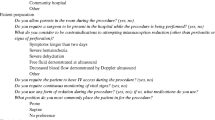Abstract
To determine what practices are being utilized in the management of intussusception, a survey was sent to chairpersons of 64 Pediatric Radiology departments in the United States and Canada. There was a 92% response rate. Barium is used in 97% of departments and is the most commonly used contrast-agent in 64%. Water-soluble contrast is used in 83% of departments and air in 50%. In high-risk patients, water soluble contrast is used in 71% of departments, air in 28% and barium in 24%. Glucagon, pre-exam antibiotics, and pre-exam sedation are not used regularly in a majority of departments. The radiologic management of intussusception is more varied than only a few years ago. Use of water-soluble contrast and air have increased, while barium use is less routine.
Similar content being viewed by others
References
Campbell JB (1989) Contrast media in intussusception. Pediatr Radiol 19:293–296
Bisset III GS, Kirks DR (1988) Intussusception in infants and children: diagnosis and therapy. Radiology 168:141–145
Ravitch MM (1986) Intussusception. In: Welch KJ, Randolph JG, Ravitch MM, O'Neill JA, Rowe MI (eds) Pediatric surgery, 4th edn. Year Book Medical Publishers, Chicago, pp 868–882
Touloukian RJ, O'Connell JB, Markowitz RI, Rosenfield N, Seashore JH, Ablow RC (1987) Analgesic premedication in the management of ileocolic intussusception. Pediatrics 79:432–434
Franken EA, Smith WL, Chernish SM, Campbell JB, Fletcher BD, Goldman HS (1983) The use of glucagon in hydrostatic reduction of intussusception: a double-blind study of 30 patients. Radiology 146:687–689
Mortensson W, Eklof O, Laurin S (1984) Hydrostatic reduction of childhood intussusception: the role of adjuvant glucagon medication. Acta Radiol Diagn 25:261–264
Hsiao JY, Kao HA, Shih SL (1988) Intravenous glucagon in hydrostatic reduction of intussusception: a controlled study of 63 patients. Acta Paediatr Sin 29:242–246
Franken Jr EA (1988) Nonsurgical treatment of intussusception. AJR 150:1353–1354
Sheh YH, Ting WH, Yeh HH (1964) Reduction of intestinal intussusception in infancy by colonic air insufflation. Chin Med J 83: 668–673
Zhang J, Wang Y, Wei L (1986) Rectal inflation reduction of intussusception in infants. J Pediatr Surg 21:30–32
Fiorito ES, Cuestas LAR (1959) Diagnosis and treatment of acute intestinal intussusception with controlled insufflation of air. Pediatrics 24:241–244
Gu L, Alton DJ, Daneman A et al (1988) Intussusception reduction in children by rectal insufflation of air. AJR 150:1345–1348
Stringer DA, Ein SH (1990) Pneumatic reduction: advantages, risks and indications. Pediatr Radiol 20:475–477
Palder SB, Ein SH, Stringer DA, Alton D (1991) Intussusception: barium or air? J Pediatr Surg 26:271–275
Shiels II WE, Maves CK, Heldund GL, Kirks DR (1991) Air enema for diagnosis and reduction of intussusception: clinical experience and pressure correlates. Radiology 181:169–172
Wang G, Liu S (1988) Enema reduction of intussusception by hydrostatic pressure under ultrasound guidance: a report of 377 cases. J Pediatr Surg 23:814–818
Todani T, Sato Y, Watanabe Y, Toki A, Uemura S, Urushihara N (1990) Air reduction for intussusception in infancy and childhood: ultrasonographic diagnosis and management without X-ray exposure. Z Kinderchir 45:222–226
Cochran DQ, Almond CH, Shucart WA (1963) An experimental study of the effects of barium and intestinal contents on the peritoneal cavity. AJR 89:883–887
Ginai AZ (1985) Experimental evaluation of various available contrast agents for use in the gastrointestinal tract in cases of suspected leakage. Effects on peritoneum. Br J Radiol 58:969–978
Humphry A, Ein SH, Mok PM (1981) Perforation of the intussuscepted colon. AJR 137:1135–1138
Armstrong EA, Dunbar JS, Graviss ER, Martin L, Rosenkrantz J (1980) Intussusception complicated by distal perforation of the colon. Radiology 136:77–81
Phelan E, de Campo JF, Malecky G (1988) Comparison of oxygen and barium reduction of ileocolic intussusception. AJR 150: 1349–1352
Collins DL, Pinckney LE, Miller KE et al (1989) Hydrostatic reduction of ileocolic intussusception: a second attempt in the operating room with general anesthesia. J Pediatr 115:204–207
Author information
Authors and Affiliations
Rights and permissions
About this article
Cite this article
Meyer, J.S. The current radiologic management of intussusception: A survey and review. Pediatr Radiol 22, 323–325 (1992). https://doi.org/10.1007/BF02016244
Received:
Accepted:
Issue Date:
DOI: https://doi.org/10.1007/BF02016244




